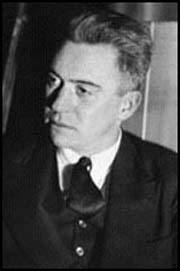 Harold Hart Crane (July 21, 1899 in Garrettsville, Ohio, United States – April 26, 1932) was a U.S. poet.
Harold Hart Crane (July 21, 1899 in Garrettsville, Ohio, United States – April 26, 1932) was a U.S. poet.
Hart Crane’s father, Clarence, was a successful Ohio businessman who had made his fortune in the candy business by inventing the Life Saver. Crane’s mother and father were constantly fighting, and in 1916 they divorced. It was shortly thereafter that Hart dropped out of high school and headed to New York City. Between 1917 and 1924 he moved back and forth between New York and Cleveland, working as an advertising copywriter and a worker in his father’s factory.
From Crane’s letters, it appears that New York was where he felt most at home, and much of his poetry is set there. Crane was gay. Part of his love for New York may have sprung from its tolerance as well as its thriving gay subculture.
Throughout the early 1920s, small but well-respected literary magazines published some of Crane’s lyrics, gaining him, among the avant-garde, a respect that White Buildings (1926), his first volume, ratified and strengthened. White Buildings contains many of Crane’s best lyrics, including “For the Marriage of Faustus and Helen,” and a powerful sequence of erotic poems called “Voyages,” written while he was falling in love with Emil Opffer, a Danish merchant marineman.
“Faustus and Helen” was part of a larger artistic struggle to meet modernity with something more than despair. Crane identified T.S. Eliot with that kind of despair, and while he acknowledged the greatness of The Waste Land, he also said it was “so damned dead,” an impasse, and a refusal to see “certain spiritual events and possibilities.” Crane’s self-appointed work would be to bring those spiritual events and possibilities to poetic life, and so create “a mystical synthesis of America.” He meant an epic poem. This ambition would finally issue in The Bridge (1930), where the Brooklyn Bridge is both the poem’s central symbol and its poetic starting point.
The Bridge got mostly bad reviews, but much worse than that was Crane’s sense that he had not succeeded in his goal. It was during the late ’20s, while he was finishing The Bridge, that his drinking, always a problem, got notably worse. The partial failure of the poem perhaps had something to do with his increasing alcoholism.
While on a Guggenheim Fellowship in Mexico in 1931-32, his drinking continued while he suffered from bouts of alternating depression and elation. His only heterosexual affair with Peggy Cowley, the wife of his friend Malcolm Cowley was one of the few bright spots, and “The Broken Tower,” his last great lyric poem (maybe his greatest lyric poem), emerges from that affair. Crane still felt himself a failure, though, and just before noon on April 26, 1932, on a steamship passage back to New York from Mexico right after he was beat up from hitting on a male crewmember, which may have confirmed the idea that he could not be happy in this world as a gay man he jumped into the Gulf of Mexico, committing suicide.

